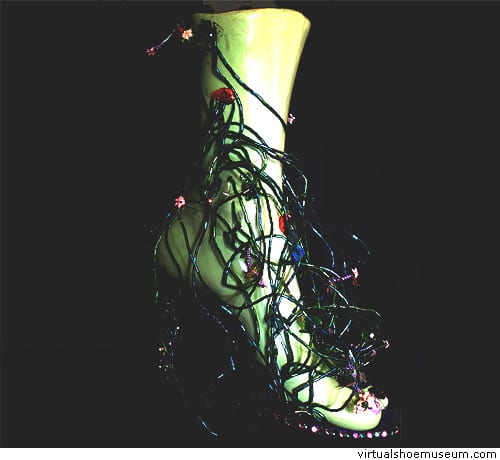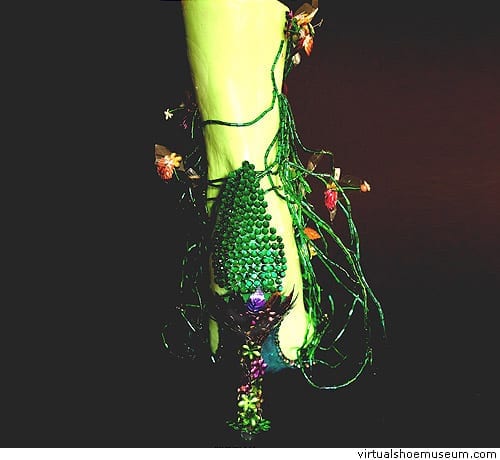This shoe sculpure is part of a series of 20 sculptures of shoes dedicated to the most relevant women in history, literature, cinema and comics. This project has been commissioned by Superstudio Milan and ANCI, and chosen as opening event for the MICAM 2006.
Ophelia (Shakespeare’s Hamlet)
Aside from being one of the greatest poets and theatre’s writers, Shakespeare was also a pioneer of cinema, particularly for its primary root, the screenplay. His “Hamlet” is a clear example of that. We know that the little Ophelia will kill herself in the bed of a creak. As in every kind of performance, being it theatrical, pictorial or cinematographic, she is portrayed well dressed and perfectly make up as if she was going out on a date, not certainly to a rendezvous with Death. There are flowers on her hands and scattered across her clothes. The corpse is settled into water as if someone pitifully wanted to give her a post mortem dignity. The dialogue between the undertakers (the clowns, that in Shakespeare’s theatre bring Death) insinuates the doubt of the presence of a mysterious character, an “hidden2 assassin moving in the neighbourhood of the court or as a scene that has been intentionally cut off to rise up the suspense and the sense of apprehension, as in an Hitchcock or David Lynch’s film. The screenplayer’s job, before that of the director’s is that of catching audiences’ attention through the delicate duties of not giving clues, not explaining and principally not showing. So, the undertakers ask themselves on how weird is to bury a suicidal in consecrated earth and draw the brilliant conclusion “the lady drowned herself for self-defence”. Water is by far the purifier element, it’s the catharsis into which even the blackest assassin can clean his crimes off. In “Psycho”, Norman Bates hides his victim into water, so does the psycopath Jame Gumb in “The silence of the lambs” and in “Twin Peaks” the corpse of Laura Palmer floats in plastic to make her finding possible. The sandal of Ophelia is the one she could be dressing when the corpse free itself from the flesh and skin, and instead of worms and moulds I’d like to imagine flowers, leaves and threads of grass made of beads and slips of PET as natural “product” and consequently, a decoration exhaled by herself.

